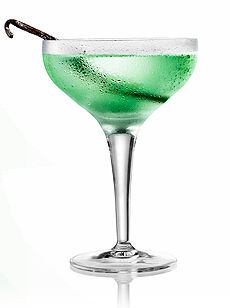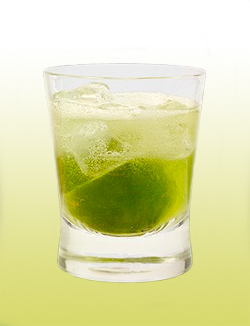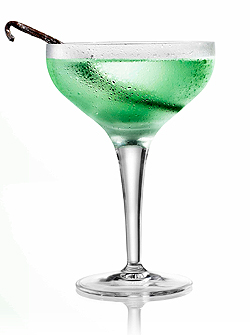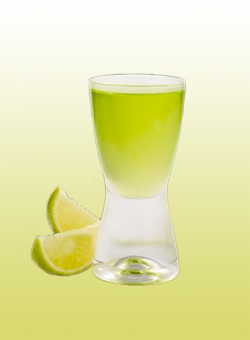

The drinkin’ o’ the green: Enjoy a special cocktail on St. Patrick’s Day. All photography courtesy Agwa de Bolivia.
March 2010 |
 |
Green Cocktails For St. Patrick’s Day
With Agwa Coca Leaf Liqueur
CAPSULE REPORT: Want a green drink to celebrate St. Patrick’s Day? Put down the green food coloring, and don’t touch that green beer! Instead, make yourself a lovely green cocktail with Agwa de Bolivia coca leaf liqueur. Created in Amsterdam from coca leaves grown in Bolivia, and enhanced with 36 herbs and botanicals, Agwa tastes herbal with a strong lime note. Its emerald green color makes it a perfect candidate for a St. Patrick’s Day drink.
Cocktail Menu
History Of The Coca Leaf
Agwa Fresca
Ingredients Per Cocktail
- 2 ounces Agwa
- 1 ounce soda water
- 2 lime wedges
- 1 ounce fresh lime juice
Preparation
- Squeeze 2 lime wedges into a rocks glass, and the drop in the limes.
- Add ice cubes, Agwa and soda water.
|
|
 |
Amsterdam Martini
Ingredients Per Cocktail
- 1-1/2 parts Agwa
- 1-1/2 parts citron vodka
Preparation
- Shake ingredients in a martini shaker with ice.
- Strain into a chilled martini glass.
- Garnish with a vanilla bean.
|
|
 |
Bolivian Kiss
Ingredients Per Cocktail
- 1 ounce Agwa
- 1 lime wedge
Preparation
- Pour Agwa into a chilled shot glass.
- Bite the lime wedge.
- Down the Agwa shot.
|
|
 |
The History Of The Coca Leaf
Coca leaf use dates back thousands of years. Used by Bolivian farmers for its energy giving properties, to its misuse in the production of cocaine, the coca leaf has always attracted controversy. It is as famous for its many virtues as its many vices. Agwa allows you to enjoy the virtues of the coca leaf in drinks and cocktails—legally. Does it have the same impact as the illegal use? We’re guessing not.
Coca leaves have been chewed by South American Indians for 4,500, years to induce a mild and long-lasting euphoria. Anthropologists have speculated that the word coca derives from the pre-Incan Tiwanaku word khoka—meaning “the plant.” The Aymara word q’oka means “food for travellers and workers.” It was found that 100 grams of Bolivian coca leaves satisfied the dietary allowance for calcium, iron, phosphorous, vitamin A, vitamin B and vitamin E. The coca leaf was used (and still is) by the Incas, Inca descendants (Quechuans), Tiwanaku, Amyara and other nomadic Andean cultures.
In 1859, Albert Niemann isolated the alkaloid cocaine. By 1868, cocaine had been recognized as an excellent local anaesthetic, and in 1884, Freud wrote about his experience with cocaine in “Uber Coca.” In 1860, Angelo Mariani introduced “Vin Mariani,” a fortified wine drink made with coca leaf. Mariani and other makers of coca leaf liquors made a fortune from the drink with the help of endorsement by such notable people as Queen Victoria of England, Thomas Edison and Pope Leo the XIII.
In 1886, John Pemberton, of Atlanta, Georgia, introduced Coca-Cola which contained cocaine. Cocaine was removed from Coca Cola in 1904; however, de-cocainised coca leaves are still used in its production today. Cocaine, and wines and liquors made with cocaine, were banned in 1912.
Today you can legally enjoy the taste experience of de-cocainised Bolivian coca in Agwa de Bolivia. Today, bales of Bolivian coca leaf are shipped under armed guard to Amsterdam where they are distilled. An extremely distinctive peppery herbal base is then blended with other herbs like guarana and ginseng to balance the taste and augment the effect. Agwa de Bolivia recommends using lime to get maximum effect out of the spirit. Biting the lime first works in the same way as the South American practice of chewing Coca leaves with limes. The lime changes the PH of the mouth, which activates the alkaloids in the leaf to produce a powerful oxygen buzz.
Recipes courtesy Agwa de Bolivia. All other materials

|